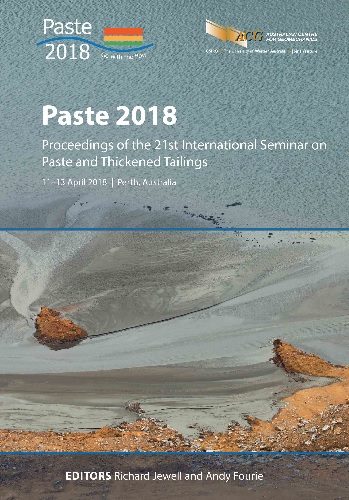Analysis of dewatering and desaturation of generic field deposition scenarios for thickened tailings

|
Authors: Qi, S; Simms, P |
DOI https://doi.org/10.36487/ACG_rep/1805_33_Simms
Cite As:
Qi, S & Simms, P 2018, 'Analysis of dewatering and desaturation of generic field deposition scenarios for thickened tailings', in RJ Jewell & AB Fourie (eds), Paste 2018: Proceedings of the 21st International Seminar on Paste and Thickened Tailings, Australian Centre for Geomechanics, Perth, pp. 401-412, https://doi.org/10.36487/ACG_rep/1805_33_Simms
Abstract:
Models that compute dewatering using accurate coupling of evaporation, unsaturated flow and large strain consolidation may have utility in providing guidance to optimise deposition of thickened tailings. A recently developed research model, UNSATCON, is used to analyse some typical field deposition profiles for both hard rock and oil sands fine tailings deposits. Model parameters are selected from previous studies on hard rock and oil sands tailings. Some validation with select field data is presented. Exploratory analysis reveals a number of interesting findings. For hard rock tailings, where self-weight consolidation after lift placement occurs relatively quickly due to high hydraulic conductivity of the tailings, maximisation of density can be achieved for a wide range of lift thickness and rates of rise even with relatively low rates of evaporation. For desaturation and risk of oxidation, lift thickness and deposition timing become more important. For oil sands tailings, the timing of deposition and lift thickness are more important for maximising density due to the much lower hydraulic conductivity and, therefore, the longer time of self-weight consolidation.
Keywords: consolidation, unsaturated flow, field deposition, density, saturation, oxidation
References:
Al, TA & Blowes, DW 1995, A Geochemical, Hydrogeological and Hydrological Study of the Tailings Impoundment at the Falconbridge Limited, Kidd Creek Division Metallurgical Site, Timmins, Ontario, Mend Report 2.23.2d, viewed 15 February 2018,
Al-Tarhouni, M, Simms, P & Sivathayalan, S 2011, ‘Cyclic behaviour of reconstituted and desiccated samples of thickened gold mine tailings’, Canadian Geotechnical Journal, vol. 48, no. 7, pp. 1044–1060.
Bryan, R Simms, P & Verburg, R 2010, ‘Coupling oxidation to transient drying in surface deposition of thickened tailings’, Minerals Engineering, vol. 23 pp. 1101–1112.
Daliri, F, Simms, P & Sivathayalan, S 2016, ‘Shear and dewatering behaviour of high density gold tailings in a laboratory simulation of multi-layer deposition’, Canadian Geotechnical Journal, vol. 53, pp. 1246–1257.
Daliri, F, Kim, H, Simms, P & Sivathayalan, S 2014, ‘Impact of desiccation on monotonic and cyclic shear strength of thickened gold tailings’, Journal of Geotechnical and Geoenvironmental Engineering, vol. 140, no. 9, pp. 04014048-1–04014048-13.
Fox, PJ & Berles, JD 1997, ‘CS2: A piecewise-linear model for large strain consolidation’, International Journal for Numerical and Analytical Methods in Geomechanics, vol. 27, pp. 453–475.
Jeeravipoolvarn, S, Scott, JD & Chalaturnyk, RJ 2009, ‘10 m standpipe tests on oil sands tailings: Long-term experimental results and prediction’, Canadian Geotechnical Journal, vol. 46, no. 8, pp. 875–885.
Kam, S, Girard, J, Hmidi, N, Mao, Y & Longo, S 2011, 'Thickened tailings disposal at Musselwhite Mine', in RJ Jewell and AB Fourie (eds), Proceedings of the 14th International Seminar on Paste and Thickened Tailings, Australian Centre for Geomechanics, Perth, pp. 225–236.
Qi, S 2017, Numerical Investigation on Slope Stability of Expansive soils and Large Strain Consolidation of Soft Soils, PhD dissertation, University of Ottawa/Ottawa-Carleton Institute for Graduate studies in Civil Engineering, Ottawa, 520 p.
Qi, S, Simms, P Vanapalli, S 2016a, ‘Piecewise-linear formulation of coupled large strain consolidation and unsaturated flow.
I: model development and implementation’, Journal of Geotechnical and Geoenvironmental Engineering, vol. 143, no. 7,
Qi, S, Simms, P, Vanapalli, S & Soleimani, S 2016b, ‘Piecewise-linear formulation of coupled large strain consolidation and unsaturated flow. II model calibration and testing’, ASCE Journal of Geotechnical and Geoenvironmental Engineering.
Qi, S, Daliri, F Simms, P Vanapalli, S 2016c, ‘A large strain consolidation-unsaturated flow model for tailings analysis: multilayers’, Proceedings of the 69th Canadian Geotechnical Conference.
Qi, S, Salam, M & Simms, P 2017, ‘Modelling thixotropy at short and long time scales in dewatering analyses for soft soil or tailings’, Proceedings the 70th Canadian Geotechnical Conference.
Qiu, Y & Sego, DC 2001, ‘Laboratory properties of mine tailings’, Canadian Geotechnical Journal, vol. 38, pp. 183–190.
Salam, M, Simms, P & Ormeci, B 2017, ‘Investigation of creep in polymer amended oil sands tailings’, Proceedings of the 70th Canadian Geotechnical Conference.
Simms, P 2016, ‘2013 Colloquium of the Canadian Geotechnical Society: Geotechnical and geoenvironmental behaviour of highdensity tailings’, Canadian Geotechnical Journal, vol. 54, no. 4, pp. 455–468.
Simms, P, Soleimani, S, Mizani, S, Daliri, F, Dunmola, A, Rozina, E & Innocent-Bernard, T 2017, ‘Cracking, salinity and evaporation in mesoscale drying experiments on three types of tailings’, Environmental Geotechnics,
Vu, HQ & Fredlund, DG 2006, ‘Challenges to modelling heave in expansive soils’, Canadian Geotechnical Journal, vol. 43,
pp. 1249–1272.
Wheeler, SJ, Sharma, RS & Buisson, MSR 2003, ‘Coupling of hydraulic hysteresis and stress–strain behaviour in unsaturated soils’, Géotechnique, vol. 53, pp. 41–54.
Zhang, X & Lytton, RL 2009, ‘Modified state-surface approach to the study of unsaturated soil behavior. Part I: basic concept’, Canadian Geotechnical Journal, vol. 46, pp. 536–552.
© Copyright 2025, Australian Centre for Geomechanics (ACG), The University of Western Australia. All rights reserved.
View copyright/legal information
Please direct any queries or error reports to repository-acg@uwa.edu.au
View copyright/legal information
Please direct any queries or error reports to repository-acg@uwa.edu.au



